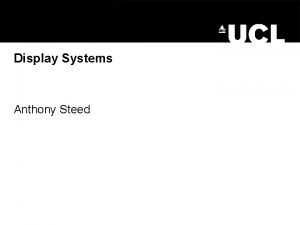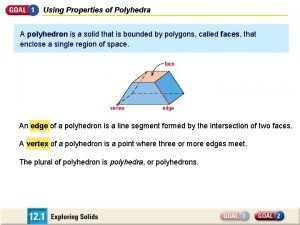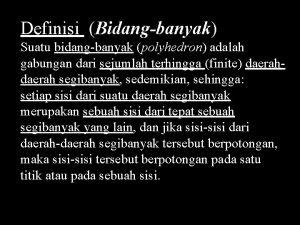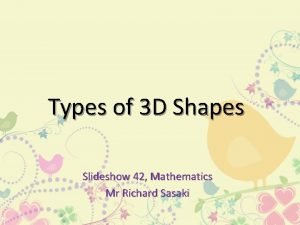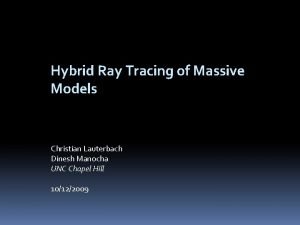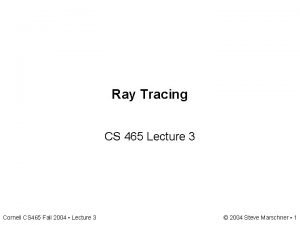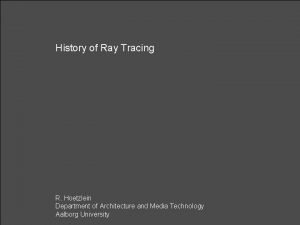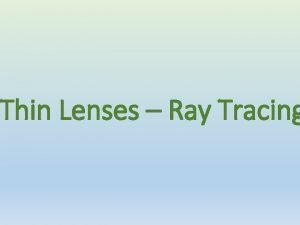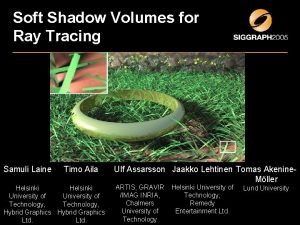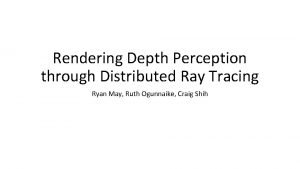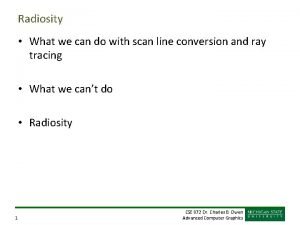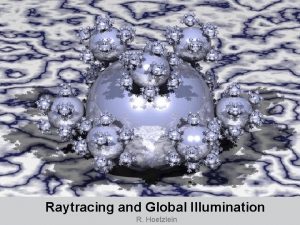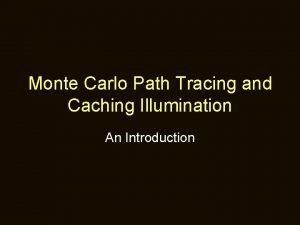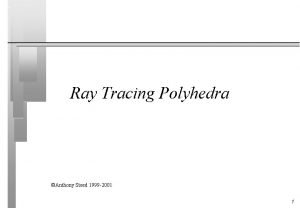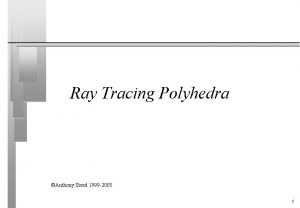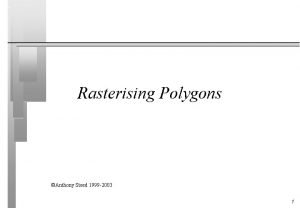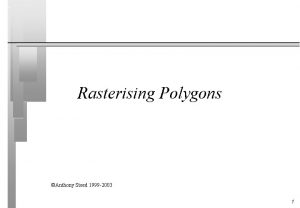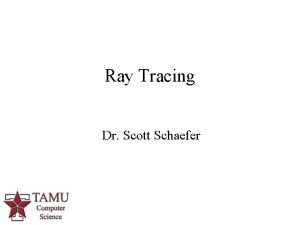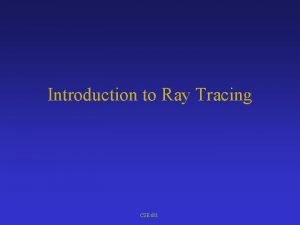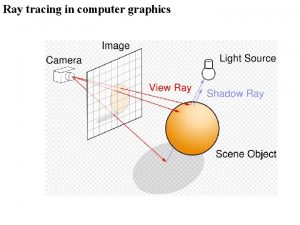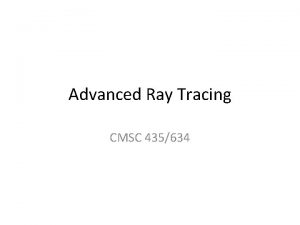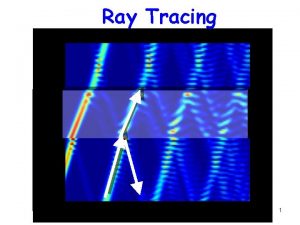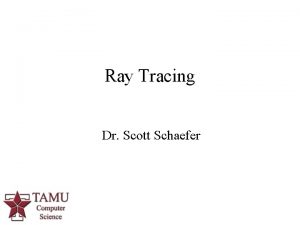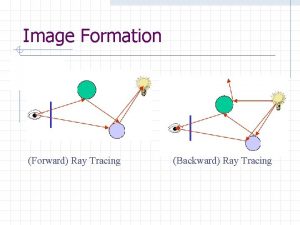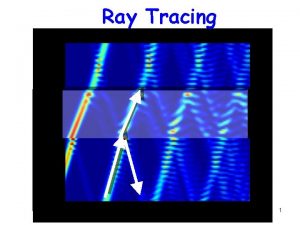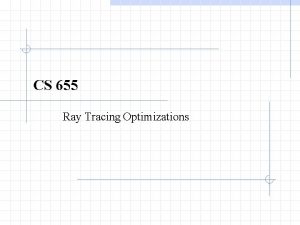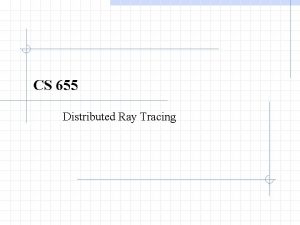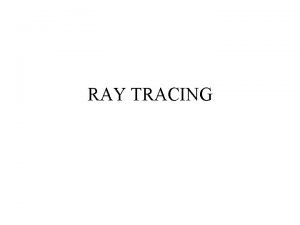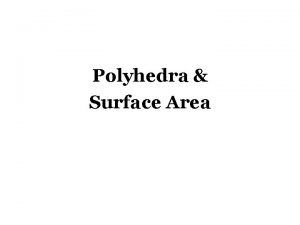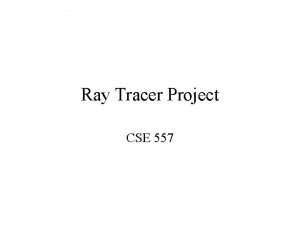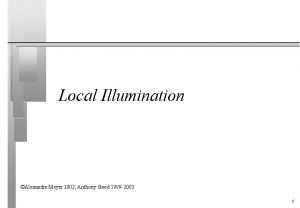Ray Tracing Polyhedra Anthony Steed 1999 2003 1




















- Slides: 20

Ray Tracing Polyhedra ©Anthony Steed 1999 -2003 1

Overview Barycentric coordinates n Ray-Polygon Intersection Test n Affine Transformations n 2

Line Equation n Recall that given p 1 and p 2 in 3 D space, the straight line that passes between is: for any real number t n This is a simple example of a barycentric combination 3

A Barycentric Combination is n a weighted sum of points, where weight sum to 1. • Let p 1, p 2, …, pn be points • Let a 1, a 2, …, an be weights 4

Implications If p 1, p 2, …, pn are co-planar points then p as defined will be inside the polygon defined by the points n Plenty of diagrams n 5

Outline of Polygon Ray Tracing n Three steps • Does the ray intersect the plane of the polygon? – i. e. is the ray not orthogonal to the plane normal • Intersect ray with plane • Test whether intersection point lies within polygon on the plane 6

Does the ray intersect the plane? Ray eq. is p 0 + t. d n Plane eq. is n. (x, y, z) = k n n Then test is n. d !=0 7

Where does it intersect? n Substitute line equation into plane equation n Solve for t n Find pi 8

Is this point inside the polygon? n If it is then it can be represented in barycentric co-ordinates. n Many tests are possible • Winding number (can be done in 3 D) • Infinite ray test (done in 2 D) • Half-space test (done in 2 D for convex poylgons) 9

Winding number test Sum the angles subtended by the vertices. If sum is zero, then outside. If sum is +/-2 , inside. n With non convex shapes, can get +/4 , +-6 , etc… n p 2 1 p 1 n-1 pn-1 10

Infinite Ray Test n Draw a line from the test point to the outside • Count +1 if you cross an edge in an anti-clockwise sense • Count -1 if you cross and edge in a clockwise sense n n -1 +1 For convex polygons you can just count the number of crossings, ignoring the sign If total is even then point is outside, otherwise inside 11

Half-Space Test (Convex) n A point p is inside a polygon if it is in the negative half-space of all the line segments 12

Transformations Revisited Homogenous transform as described is affine n Preserves barycentric co-ordinates n n f is affine iff f (p ) = å a i f (pi ) n i =1 n p = åa i pi i =1 n åa i =1 13

To Show Transformation is Affine Unit vectors e 1=(1 0 0), e 2=(0 1 0), e 3=(0 0 1) and e 4=(0 0 0) n p=(x 1 x 2 x 3) n Let x 4=1 -x 2 -x 3 n Thus n 14

. . . n But for unit vectors, mapping is easy to derive 15

… n So combine those two 16

. . . n But we know x 4=1 -x 2 -x 3 17

. . . n Expand that, remembering what ei is n But this is the matrix transformation 18

Why? If a rotation, scale, translation are affine then barycentricity is preserved n If barycentricity is preserved then polygons are still flat after transformation n 19

Recap Lines and polygons (and volumes) can be determined in terms of barycentric coordinates n We have shown that homogenous transformations are, by definition, affine n This polygons remain “flat” n Thus we now can use arbitrary transformations on polyhedra n 20
 Ray tracing and ray casting
Ray tracing and ray casting Policies governing language use in the philippines
Policies governing language use in the philippines Tony steed
Tony steed Robin steed
Robin steed Simon steed
Simon steed O what can ail thee knight-at-arms meaning
O what can ail thee knight-at-arms meaning Properties of polyhedrons
Properties of polyhedrons Jenis-jenis polyhedron
Jenis-jenis polyhedron Regular polyhedra
Regular polyhedra Ray tracing lenses
Ray tracing lenses Hybrid ray tracing
Hybrid ray tracing Albrecht dürer ray tracing
Albrecht dürer ray tracing History of ray tracing
History of ray tracing Thin lens ray tracing
Thin lens ray tracing Samuli laine
Samuli laine Depth
Depth Ray tracing vs radiosity
Ray tracing vs radiosity Urmi ray
Urmi ray Rasterization vs ray tracing
Rasterization vs ray tracing Monte carlo ray tracing
Monte carlo ray tracing Raytrace technologies
Raytrace technologies


